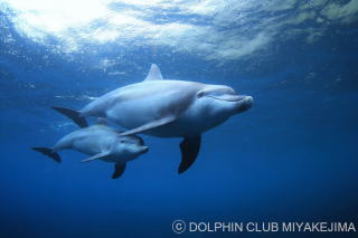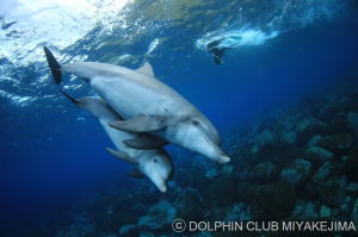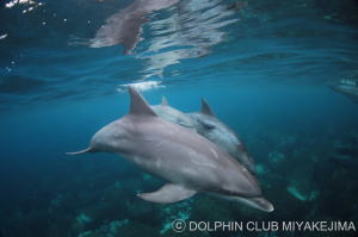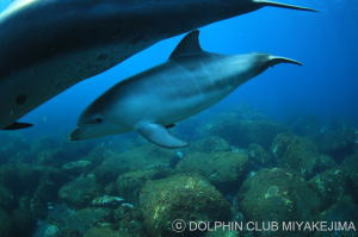| Dolphin Club MIYAKEJIMA |
Japanese |
|
|
Dolphins that live in the coastal waters of Mikura Island
|
|
 |
Japanese
name |
ミナミバンドウイルカ
南坂東海豚
(Minami Bandou Iruka)
or
ミナミハンドウイルカ
南半道海豚
(Minami Handou Iruka) |
| Scientific name |
Tursiops aduncus |
| English name |
Indo-Pacific Bottlenose Dolphin |
Chinese
name |
印度太平洋宽吻海豚
or
印太平洋瓶鼻海豚 |
| Taxonomic position |
| Artiodactyls Cetacea Delphinidae |
| Recently, it has been discovered that dolphins and whales are closely related
to camels and cows, especially hippos. This species was thought to be the
same species as the bottlenose dolphin that can be seen in aquariums (and
was once seen), but in 2000 it was determined to be a different species. |
| Where Indo-Pacific bottlenose dolphins live |
| They are found in the Indian Ocean to the western Pacific Ocean, and although
they occasionally migrate from the coast of Mikurajima to the surrounding
islands, they tend to live in coastal areas.In contrast, bottlenose dolphins
migrate long distances offshore. |
| Physical characteristics |
 |
They are slightly smaller than bottlenose dolphins, with a body length
of about 2.7m. On the other hand, bottlenose dolphins can grow to a maximum
of 3.8m. Also, compared to bottlenose dolphins, their snouts (the beak-like
part) are longer and thinner, and the curve at the rear end of their dorsal
fins is smaller and their shape tends to be closer to triangular. As Indo-Pacific
bottlenose dolphins grow, a spotted pattern appears on their abdomen.
|
| The sounds made by dolphins |
Indo-Pacific bottlenose dolphins make a variety of sounds.
The sounds that sound like "click, click..." and "beep" are called clicks, and are emitted into the sea from a protruding part on their forehead. By picking up the sound that hits an object and bouncing back and analyzing it with their lower jaw, it is said that they can determine what the object is and how far away it is. This is called echolocation.
The sound that sounds like a whistling "pew" is called a whistle, and is thought to be used by dolphins to communicate with each other. |
| Dolphin Skin |
 |
Although you cannot touch the dolphins during the dolphin swim, I will share a little about it, drawing on my experiences as an aquarium curator.
When they are born, they may have some hair remaining at the base of their snout, but after this falls out, Indo-Pacific bottlenose dolphins have no hair at all. Sometimes the pores become inflamed. Is that "acne"? Their skin is very smooth and quite elastic. As they get older, the skin becomes slightly more saggy, but... Sometimes, a kind of grime caused by skin metabolism appears on their skin, and when you rub it off in captivity, they sometimes seem to feel very good. Skin wounds remain white for a long time even after they have healed, and can be used to identify individual dolphins. |
| About Dolphins Swimming |
| The bottlenose dolphin, which is considered to be a closely related species,
can swim at a speed of about 30km per hour, dive for a few minutes, and
dive to a depth of more than 500m. |
| Eating habits |
| This data is from a time when they were not yet distinguished from bottlenose
dolphins, but they appear to eat a variety of fish (both those that humans
normally eat and those that we don't), squid, octopus, shrimp, etc. |
| Vision |
| Their eyesight is about 0.1 in human terms. However, they seem to have
excellent eyesight even in the dark ocean. They can see well in front and
diagonally behind, so they may be able to make eye contact even when they
are behind a dolphin. As for color, they seem to be able to distinguish
between light and dark colors, but it is not yet known whether they can
distinguish between colors such as blue, red, and yellow. |
| About dolphin growth |
 |
The gestation period is about one year, and babies about one meter
long are born.
When they are born, they still have fetal marks, a remnant of being inside the womb.
For about a year and a half after birth, they grow while receiving breast milk from their mother. (In captivity, there have been instances where they continued to peck at their mother's nipples until they were six years old...)
Until they are about three years old, they spend their time very close to their mother or a female who acts as her substitute (a babysitter), and they grow up with the help of the water currents that these individuals create to help them swim. Females reach maturity at about six years old, and males at about ten years old, and they have a lifespan of about 30 to 40 years. |
| Written by Nobuhisa Ueda |
| ○参考文献 |
| 加藤暁音 他 「いるかいないか」 御蔵島観光協会 2010年 |
| 村山司・中原史生・森恭一 編著 「イルカ・クジラ学」 東海大学出版会 2002年 |
| 村山司 編著 「鯨類学」 東海大学出版会 2008年 |
| 村山司 「イルカ」 中公新書 2009年 |
| 村山司・森阪匡通 編著 「ケトスの知恵」東海大学出版会 2012年 |
|
Dolphin Club Miyakejima
1813-1, Ako, Miyake-mura Miyakejima, Tokyo, 100-1212, Japan
TEL&FAX 04994-8-5010
E-mail dcmiyakeis@gmail.com |
| ⓒ 2018 Miyakejima Nature Service Co., Ltd. (M.N.S.) |
|



